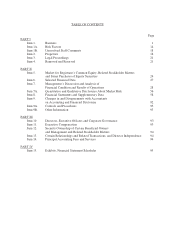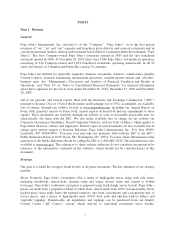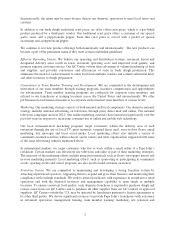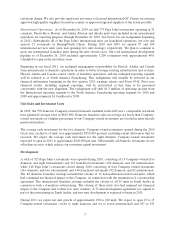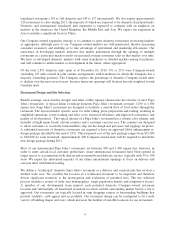Papa Johns 2010 Annual Report Download - page 17
Download and view the complete annual report
Please find page 17 of the 2010 Papa Johns annual report below. You can navigate through the pages in the report by either clicking on the pages listed below, or by using the keyword search tool below to find specific information within the annual report.10
We believe the support programs have mitigated potential unit closures and strengthened our brand
during this challenging economic environment. In addition to reducing unit closures, other important
objectives of the support program include growing market share in a consolidating category and
stabilizing transaction levels.
In December 2010, our domestic franchisees voted in favor of a proposal to increase the national
marketing fund contribution rate for 2011 to 2013 (“National Marketing Fund Agreement”). The primary
terms of the National Marketing Fund Agreement are as follows:
• National Marketing Fund Contribution Rate – Domestic Company-owned and franchised
restaurants will contribute 4.0% of sales to the Marketing Fund in 2011 and have agreed to a
minimum contribution rate in 2012 and 2013. The Company expects this agreement to primarily
represent a shift, as opposed to an increase, in total marketing spend, and believes an increase in
marketing spend on a national basis will improve the consistency of the overall marketing
message and favorably impact brand awareness, particularly in regions of the country where the
brand is currently underpenetrated.
• BIBP’s Accumulated Deficit – BIBP had an accumulated deficit (representing prior purchases of
cheese by PJFS from BIBP at below market prices) of $14.2 million at December 26, 2010. PJFS
agreed to pay to BIBP the amount equal to the accumulated deficit at December 26, 2010.
Accordingly, BIBP recorded a decrease of $14.2 million in cost of sales and PJFS recorded a
corresponding increase in cost of sales. This transaction did not have any impact on the
Company's 2010 consolidated income statement results since both PJFS and BIBP are fully
consolidated.
• Cheese Purchasing Agreement – In order to facilitate franchisees' planning of food costs and
promotions moving forward, PJFS agreed to continue to lock in the price of cheese to the system
on a period-by-period basis for franchisees willing to sign a cheese purchasing agreement with
PJFS. The cheese purchasing agreement requires the franchisee to commit to purchase cheese
through PJFS, or to pay the franchisee's pro rata portion of any accumulated cheese liability upon
ceasing to purchase cheese from PJFS when a cheese liability exists.
• Online Ordering System Fees – The Company agreed to reduce the online ordering fee paid by
domestic franchisees by 0.5% for 2011, and agreed to limit the fee for 2012 and 2013.
• Royalty Rebate Program – The standard royalty rate in 2011 is 5.0% of sales. Franchisees can
earn up to a 0.25% quarterly royalty rebate for 2011 to 2013 by meeting certain sales growth
targets, and an additional 0.20% royalty rebate in 2011 by making specified re-imaging restaurant
lobby investments. The Company agreed to consider a similar capital investment based royalty
rebate opportunity for franchisees in 2012 and 2013 as well.
International Development and Franchise Agreements. We opened our first franchised restaurant
outside the United States in 1998. Through 2010, we defined “international” to be all markets outside the
contiguous United States in which we have either a development agreement or a master franchise
agreement with a franchisee for the opening of a specified number of restaurants within a defined period
of time and specified geographic area (see “Strategy – International Operations” for 2011 reporting
changes to the International business unit). Under a master franchise agreement, the franchisee has the
right to subfranchise a portion of the development to one or more subfranchisees approved by us. Under
our current standard international development agreement, the franchisee is required to pay total fees of
$25,000 per restaurant: $5,000 at the time of signing the agreement and $20,000 when the restaurant
opens or the agreed-upon development date, whichever comes first. Under our current standard master
franchise agreement, the master franchisee is required to pay total fees of $25,000 per restaurant owned
and operated by the master franchisee, under the same terms as the development agreement, and $15,000
for each subfranchised restaurant – $5,000 at the time of signing the agreement and $10,000 when the


